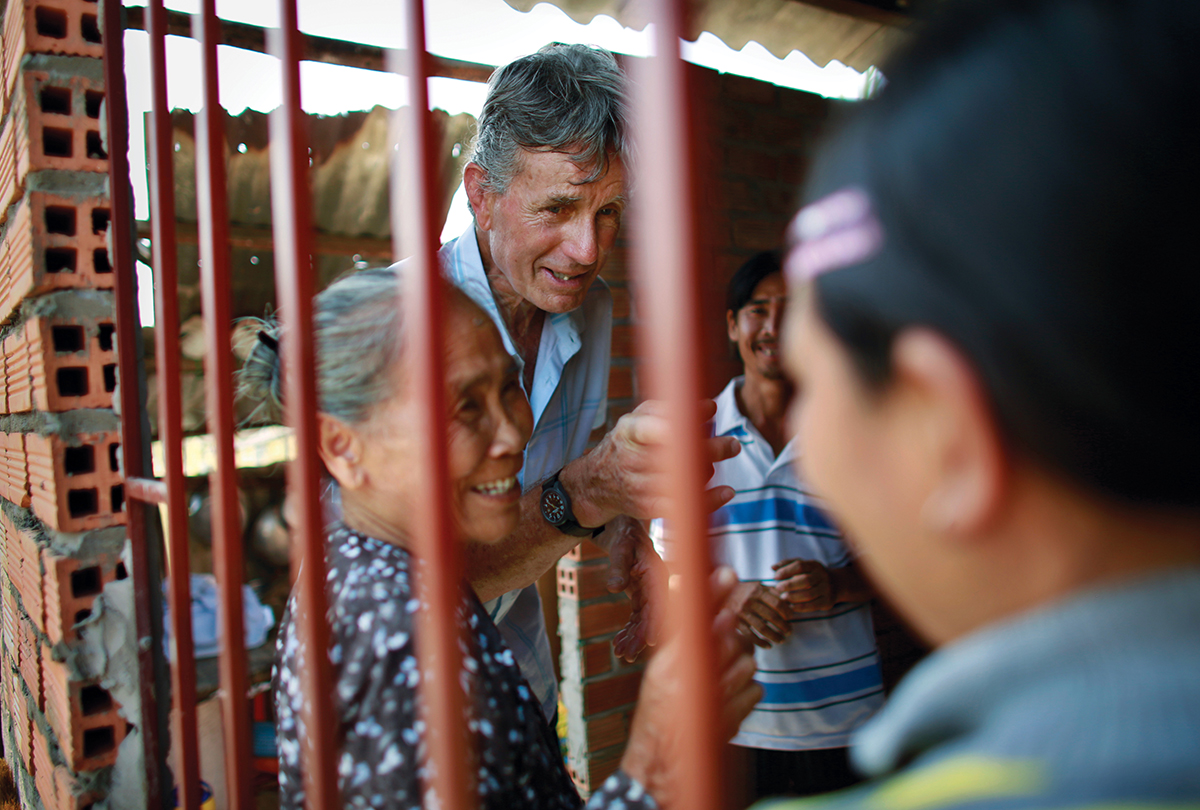John Donovan and the Ghosts of War

War veteran John Donovan greets locals in Vietnam, where he raises money to build homes for poor families. / Photograph by Stephen Katz
Almost a half century later, a subtle sound or a familiar smell can still take John Donovan back to that grisly night on the water. The sudden coolness of nightfall after a hot summer day. The odor of diesel fuel mingled with sweat. A child wailing in the distance. Some moments, Donovan has come to accept, can’t be forgotten.
On this day, though—with the sun hanging high above the Mekong Delta, as he rides a chartered tour boat along the murky brown waters he once patrolled as a young U.S. naval officer—Donovan chooses to dwell on the lighter moments from his combat tour in Vietnam.
He remembers nights spent drinking with locals in town, broken curfews and one-night stands, spitting-mad commanders and letters of reprimand. “I believe there were some concerns about my discipline,” Donovan says, shouting over the roaring boat engine. “But I think it should be said, I worked just as hard as I partied.” He recalls the time he and a South Vietnamese interpreter disguised themselves in traditional attire and rode a motorbike through enemy territory to meet up with a couple of women a few towns away. Totally worth the risk, he insists to this day.
On the river in My Tho, the lanky 6-foot-4, 72-year-old Milton native attracts stares from other boats. He smiles and waves to each, shouting hello in Vietnamese as they pass. Donovan has been coming back for nearly two decades, mostly for humanitarian purposes. He uses his corporate connections as a business consultant back home in New England to raise money to build houses for poor Vietnamese families. Every year, he travels here to meet the people he’s helped and connect with the communist government officials who allow him to do it.
In a developing country that’s been drawing more tourists of late—to bustling urban scenes such as Ho Chi Minh City, the northern mountains near Sapa, and the eastern seaside attractions around Hô°i An—Donovan spends most of his time here in the rural areas of southern Vietnam, mingling with dirt-poor rice farmers in a section of the country that hasn’t advanced much since 1965. In these parts, running water and electricity are luxuries. “Look at that,” Donovan says as he stands and walks toward the stern. Ahead in the distance, he points to a fork in the river and what appears to be a large statue. As the charter boat motors closer, the monument comes into focus: three soldiers, one holding an RPG, one holding a bazooka, and one holding an AK-47, standing atop a pedestal. Donovan asks the boat captain to pull over. He and the dozen other tourists and ex–military men onboard step onto the bank and gaze up.
The statue, about 25 feet tall and surrounded by knee-high weeds, appears long forgotten. The concrete is cracked and discolored. Plastic bottles and other trash litter the ground. The soldier holding a bazooka is missing part of his face; sunshine streams through. Our interpreter studies a faded plaque at the base of the monument, and then tells us it commemorates a North Vietnamese ambush on U.S. patrol boats here in July 1968 that claimed dozens of lives. “My tour was over by then. Missed it by a few months,” Donovan says, then stares quietly up at the monument for several seconds. “War is war,” he says finally, turning back toward the boat. “Plenty of blood spilled on both sides.”
It’s the kind of reflection I’ve heard recently from many Vietnam vets. This year marks the 50th anniversary of the United States officially entering Vietnam’s brutal civil war—a war we abandoned after 10 long years. For the men who were sent to fight, it’s been a season of soul searching. Some psychological wounds have mended, and increasingly vets are talking openly about the war that divided their generation. Some have taken it a step further and started going back.
A communist official in Vietnam responsible for escorting foreign journalists told me he’s noticed an increase in these sorts of postwar pilgrimages. Some veterans come to close a painful chapter of their lives. Some return to reconnect with their youth. Others, it seems, go just out of curiosity.
Donovan, I would learn, has come to make amends.
Nearly 3 million americans served in Vietnam between 1965 and 1975. Thousands returned with missing limbs, and more than 58,000 came home in caskets—or didn’t come home at all. The vast majority who made it back bore no visible scars, but that didn’t mean they weren’t damaged. For Donovan, rock bottom came on a sunny afternoon in the spring of 1969, one year after his return. He was 25 years old. Homeless. Addicted to prescription pills and booze. Shuffling along a crowded sidewalk in San Francisco.
Donovan also struggled with undiagnosed PTSD. His hair was long, his face unshaven, and he couldn’t remember his last shower. One day, he saw a man in a Navy uniform walking toward him and realized it was an officer under whom he’d served. Donovan hoped the man wouldn’t recognize him.
“John, how are you?” the officer asked.
“I’m doing fine,” Donovan lied.
Just three years earlier, having graduated from Holy Cross with a degree in political science, Donovan volunteered to fight in Vietnam. He believed stopping the spread of communism was a cause worth fighting for. He was young and also wanted to see what war was like. “I was going to kill some Vietcong and win medals,” he recalls thinking.
By the end of his yearlong tour, Donovan had gone on more than 200 river patrols and lived through some 50 firefights. He popped amphetamines to stay awake on overnight patrols and drank constantly off-duty to take the edge off. Those habits didn’t translate well to civilian life. The naval officer returned in 1968 disillusioned and addicted. Living with a girlfriend outside San Francisco, a jobless Donovan quickly blew through the $10,000 he was paid after separating from the military.
He’d sleep during the day and drink at night. When friends or family asked what had happened in Vietnam, he avoided giving a complete answer: “We don’t belong over there,” he’d say. Or “It wasn’t what I signed up for.” After a year, his girlfriend kicked him out, and some days later, he bumped into the former naval officer. “That was one of those crystallizing moments,” Donovan says. “I was mortified to be seen that way. The guy gave me his business card and told me to call him if I needed anything, but there was no way I was going to call. I didn’t want to talk to anyone, especially someone in the military. But that incident helped me come to terms with the fact that I needed to do something to get myself together.”
Donovan found work driving a taxi, moved into a motel room, saved up enough to rent a cheap apartment, and finally called his parents. They’d been hounding him for months to come to Boston for a visit. In the two-plus years since returning from Vietnam, he’d been home just once, and it hadn’t been a pleasant experience.
The lone homecoming came a couple of months after he returned from war. The Navy was holding a ceremony in Boston for some of the local Vietnam veterans, and they wanted Donovan there to receive the Bronze Star. “That,” he says, “was the last thing I wanted to do.”
Donovan reluctantly agreed to go, mostly to appease his parents, who’d seemed worried when he didn’t even bother to stop home after a year of combat. He got a haircut, shaved his face, had his dress uniform dry-cleaned, and bought a plane ticket back east. Donovan was one of five veterans honored that night at the Boston Navy Yard. A yellowing newspaper clipping shows Donovan standing off to the side—an uncomfortable look on his face—as an admiral pins a medal on one of the other vets. The flag officer read the award citations out loud: “Lieutenant Donovan distinguished himself by his competent and courageous performance of duty…. As a direct result of his determination and aggressiveness on patrol, Lieutenant Donovan personally accounted for a considerable number of interdicted enemy river crossings…. During his frequent encounters with the enemy, Lieutenant Donovan received enemy fire. His ensuing actions were carried out calmly, correctly, and courageously….”
Donovan couldn’t wait to get out of there, he recalls. “To me, they were using me as propaganda, trying to counter the feeling at the time that American soldiers were guilty of horrible atrocities and that we were all baby killers…. You read these award citations, and the military makes it seem like everyone who served was an infallible war hero.”
The truth, Donovan knew, is rarely so straightforward. He bit his tongue as he watched his parents smiling proudly in the audience and tried his best not to spoil the occasion. He dutifully shook the admiral’s hand and saluted. He didn’t talk much on the ride home. He remembered being back in Vietnam, where one of his officers had a saying: “What happens on the river stays on the river.”
The night he rarely talks about—the one that still haunts him—was March 20, 1967. Donovan had arrived in Vietnam only two days earlier. As the sun sank into the horizon, he readied himself to go out on his first river patrol. Later in his tour, the young officer would be responsible for leading the missions. But tonight was to serve as his education.
The riverboat pulled away from the dock at My Tho around nightfall, and the crew of sailors motored along the bank for miles. “All right, men,” the commanding officer instructed, “let’s set up an ambush.”
Donovan’s heart thumped inside his chest. He’d heard horror stories from guys who’d been in-country for a while, of Vietcong fighters attacking boat crews. He hadn’t expected to be this nervous. The crew maneuvered the boat into a narrow cove, tied it to some fishnets and pilings, then shut off the engines. Silence.
Through the darkness, Donovan could see small huts hugging the bank across the river. It was a cloudy night. For two hours, they sat quietly in near-total darkness. Then he heard a ping on the radar, a small blip on a screen moving toward them.
Soon, Donovan could hear paddling. The enemy’s vessel was less than 200 feet away, according to the radar, but it was too dark to see. Once the radar showed it within 150 feet, a crew member fired a parachute flare into the air, illuminating a 20-foot wooden sampan boat and four panicked faces on the water below.
Donovan squinted to see more clearly: Was that a woman and two children onboard? Plus an older man? It looked like a family. What the hell were they doing out there? His thought was interrupted by the deafening roar of twin 50-caliber machine guns that his crew members unleashed in the sampan’s direction. “We just blazed them,” Donovan says. “I couldn’t understand what was happening or do anything about it. I was frozen.”
The old man paddled desperately toward the shore as bullets ripped into the wooden boat. He and the woman jumped out and scrambled up the bank. She carried one of the children in her arms. But where was the other kid? The machine guns continued to fire, trailing them up the bank and into a hut.
When the shooting stopped, Donovan heard a child wailing. None of the sailors spoke. Seconds later, the old man stumbled back out of the hut. He had white hair and looked to be in his seventies. Had he somehow avoided getting hit? Then Donovan noticed the man’s hands: “This is the image I can’t ever shake,” Donovan says. “This old man just stands there, staring out at us with his arms at his stomach, holding onto his intestines as they spill out of him.”
Aboard the patrol boat, Donovan finally choked out a few words: “What are we doing?” The officer in charge turned to him: “They’re Vietcong,” he said. “This is what we do.”
Hours later, after returning to base, the commander filled out an after-action report. He marked down two Vietcong killed during the patrol, one injured. Donovan was shocked, but there was no arguing the point. For the first time in U.S. history, military leaders were measuring success in war not by the territory they controlled, but in lives claimed. The more dead Vietcong reported up the chain, the better.
Donovan couldn’t sleep after that. He lay in his bunk, contemplating what he’d seen. So, he thought, this is Vietnam.


